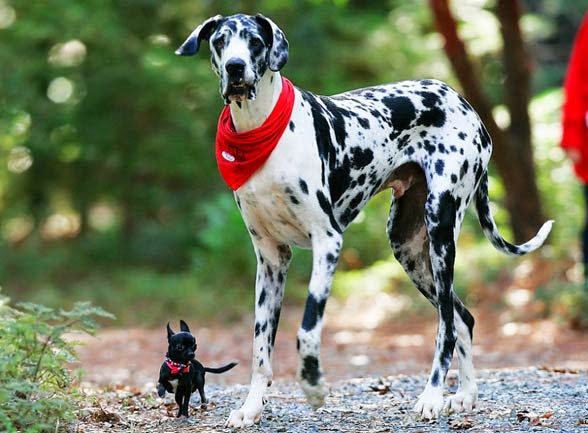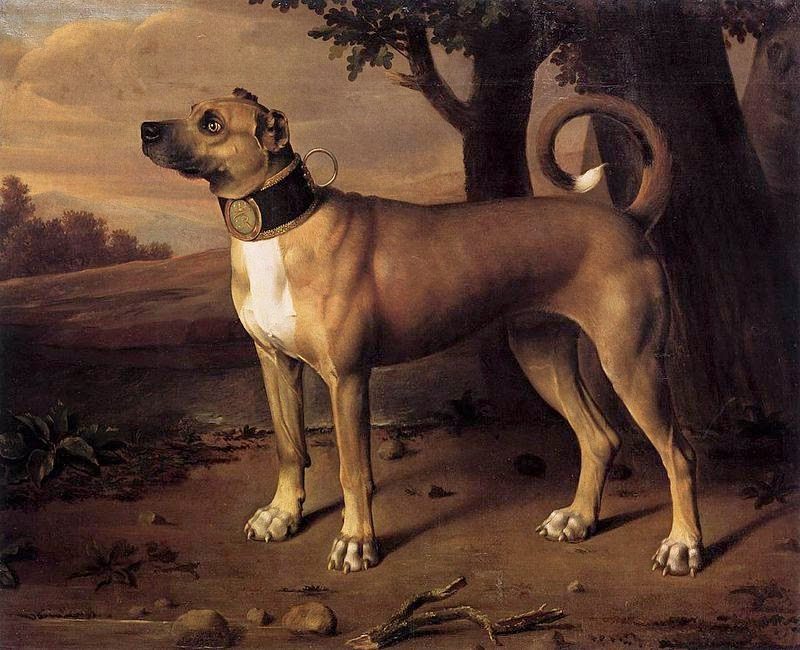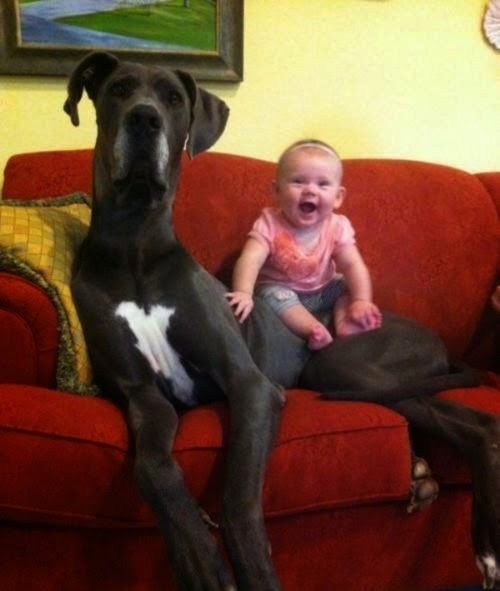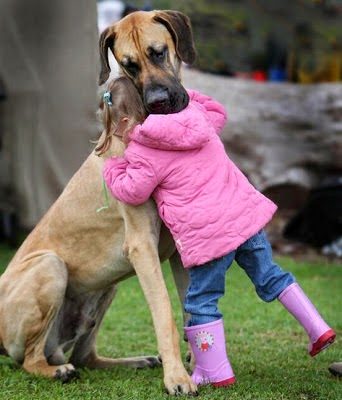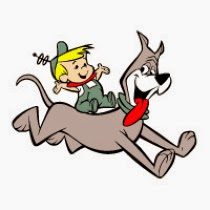Everything about your Great Dane
Very large but very gentle, this is truly a great dog. Sometimes referred to as the “Apollo of Dogs,” the Great Dane was developed in Germany for its graceful appearance, large size, and hunting ability — all important attributes to the landed gentry. These same characteristics have made the breed popular today in America, even appearing in popular culture, such as the Hanna-Barbera cartoon character Scooby-Doo, the newspaper comic character Marmaduke, and Astro in the TV show The Jetsons.
Great Danes combine robust strength with a refined dignity. In the home and around the yard, you’ll find them uniquely gifted with mental and physical strengths. Truly gentle giants, Great Danes are loving, affectionate and pleasant companions that like nothing better than to hang around the house with the family.
Overview
The Great Dane was originally bred to hunt wild boar, but he probably wouldn’t be very good at it today. The ferociousness necessary to track down such a large, wily animal was eventually bred out of the Great Dane. He’s now a gentle soul who generally gets along well with other dogs, animals, and humans.
However, his size and his power bark will scare the wits out of a burglar. Anyone who owns one of these dogs eventually understands that while you may be used to his awesome size, others usually need a little time to get there.
The Great Dane was developed from Mastiff-type dogs, but he’s more refined than other descendents of this ancient breed. A Great Dane is sleek and elegant. He has an athletic, muscular body. His massive head — and massive is the right word — is long and narrow. He’s got a long, graceful neck. His ears can be cropped or left natural.
His size can present problems. Eyeballing a dog who weighs what you do makes some folks nervous. His tail can knock over a lot of things, particularly in a small space. And given the opportunity, he’s an impressive counter surfer. Luckily, he isn’t rambunctious or highly energetic.
Size notwithstanding, a Great Dane is a sweet, affectionate companion. He loves to play and is gentle with children. He has a peaceful disposition, although he hasn’t lost any of the courageousness that helped him hunt wild boar. Although he isn’t particularly vocal , he wouldn’t hesitate to defend his family.
Even given his inherent gentleness, it’s advisable to teach him good manners and attend obedience training classes when he’s young. His sheer size alone could make him impossible to control when he’s an adult, and — as with any dog — you never know when he might see something he just has to chase.
He’s eager to please and highly people-oriented, demanding a great deal of attention from those around him. He tends to nudge people with that big old head of his when he wants to be petted. Sometimes you’ll meet one with lapdog tendencies who see no reason not to hop onto the sofa and drape themselves on you.
Surprisingly, the Great Dane typically doesn’t eat as much food as you’d think. And while he needs daily exercise, he doesn’t need a huge yard to play in.
Because of his beauty and gentle nature, more and more people are discovering the Great Dane. He currently ranks as the 24th most popular dog breed, according to registrations with the American Kennel Club.
Just be aware that because of his size, he’s got a relatively short life span of around eight years old. That means he takes up a huge space in your heart for a short amount of time.
- The Great Dane is sweet, eager to please, people-oriented, easy to housetrain, and he responds well to training using positive reinforcement.
- Like many giant dogs, Great Danes are short-lived.
- Great Danes require a lot of space. Even though they make great housedogs, they need a lot of room just to move around. There’s little that they can’t reach , and their tails can easily sweep your coffee table clean.
- Everything costs more when you have a big dog — collars, veterinary care, heartworm preventive, food. In addition, you’ll need both a crate and a vehicle that are large enough to hold your Great Dane without crumpling him into a pretzel. And let’s face it, you’ll scoop up a lot of poop.
- It takes a while for the bones and joints of large dogs such as Great Danes to stop growing and become stable. Don’t allow your Great Dane puppy to jump, and don’t take him jogging until he’s at least 18 months old; this will reduce stress on the growing bones and joints.
- The Dane’s special giant-breed dietary requirements have to be followed, or else orthopedic issues can develop.
- Great Danes aren’t particularly suited to apartments or small houses, simply because they’re so big. They’re not jumpers, fortunately, so a six-foot fence will contain them.
- To get a healthy dog, never buy a puppy from an irresponsible breeder, puppy mill, or pet store. Look for a reputable breeder who tests her breeding dogs to make sure they’re free of genetic diseases that they might pass onto the puppies, and that they have sound temperaments.
- Comparable Breeds: Boxer, Mastiff
History
Drawings of dogs who look like Great Danes have been found on Egyptian artifacts dating back to 3000 B.C. and in Babylonian temples that were built around 2000 B.C. There’s evidence that similar dogs originated in Tibet, with written reports of such dogs appearing in Chinese literature in 1121 B.C.
The breed is thought to have been taken into various parts of the world by the Assyrians, who traded their dogs to the Greeks and Romans. The Greeks and Romans then bred these dogs with other breeds. Ancestors of the English Mastiff were probably involved in the breed development, and some folks believe that the Irish Wolfhound or Irish Greyhound also may have played a role.
Great Danes originally were called Boar Hounds, because boars were what they were bred to hunt. Their ears were cropped to prevent boar tusks from tearing them. In the 16th century, the name of the breed was changed to “English Dogges.“
Late in the 1600s, however, many German nobles began keeping the largest and most handsome of their dogs in their homes, calling them Kammerhunde . These dogs were pampered and wore gilded collars lined with velvet. Talk about a sweet life.
The name Great Dane arose in the 1700s, when a French naturalist traveled to Denmark and saw a version of the Boar Hound who was slimmer and more like a Greyhound in appearance. He called this dog Grand Danois, which eventually became Great Danish Dog, with the more massive examples of the breed called Danish Mastiffs. The name stuck, even though Denmark did not develop the breed.
Most breed historians give credit to German breeders for refining the breed to be the well-balanced, elegant dog we love today. In 1880, breeders and judges held a meeting in Berlin and agreed that since the dogs they were breeding were distinctly different from the English Mastiff, they would give it its own name — German Dog.
They founded the Deutscher Doggen-Klub of Germany, and many other European countries took up the name as well. The Italians and English-speaking countries didn’t accept this name, however.
Throughout the late 1800s, wealthy German breeders continued to refine the breed. They turned their attention to the dog’s temperament, because Great Danes had aggressive, ferocious temperaments due to the fact that they were originally bred to hunt wild boar, a particularly ferocious beast. These breeders tried to produce more gentle animals, and — luckily for us today — they succeeded.
We don’t know when the first Great Danes were brought to the U.S., or even where they came from, but the Great Dane Club of America was formed in 1889. It was the fourth breed club allowed to join the American Kennel Club.
Personality
A well-bred Dane is one of the best-natured dogs around. He’s a gentle, sweet, affectionate pet who loves to play and is relaxed with children. He has a great desire to please, which makes him easy to train.
The Great Dane wants to be where the family is. He likes people a lot, including strangers and children, and will welcome visitors happily, unless he thinks you need defending. Then he can be fiercely protective.
Some Danes wish they were lapdogs, and they’ll keep trying to get there even if you and your lap mysteriously keep moving.
Good-natured as they are, Great Danes definitely need early socialization — exposure to many different people, sights, sounds, and experiences — when they’re young. Socialization helps ensure that your Great Dane puppy grows up to be a well-rounded dog.
Enrolling him in a puppy kindergarten class is a great start. Inviting visitors over regularly, and taking him to busy parks, stores that allow dogs, and on leisurely strolls to meet neighbors will also help him polish his social skills.
Is this breed right for you?
As one of the tallest and largest breeds in the world, it’s plain to see the Great Dane needs ample space to stretch its legs; however, due to its calm and lazy disposition, this breed can adapt to smaller dwellings. By nature, this is an athletic breed and daily exercise is required to keep the Great Dane in tip-top health. Great Danes love to be around people and do very well with families of all ages and sizes. Owners with very young children will want to make sure training and socialization is implemented early on as this extra-large breed could be a hazard to small children if not properly trained. This breed is prone to a short lifespan and may suffer from bloat. Owners should be prepared for potential health hazards and vet visits.
Health
Great Danes, like most giant dogs, have a fairly slow metabolism. This results in less energy and less food consumption per pound of dog than in small breeds. Great Danes have some health problems that are common to large breeds, including bloat (gastric dilatation volvulus(GDV)). The average life span of Great Danes is 6 to 8 years. Like many larger breeds, Great Danes are at particular risk for hip dysplasia.
Dilated cardiomyopathy (DCM) and many congenital heart diseases are also commonly found in the Great Dane, leading to its nickname: the Heartbreak breed, in conjunction with its shorter lifespan. Great Danes also may carry the merle gene, which is part of the genetic makeup that creates the harlequin coloring.
The merle gene is an incomplete dominant, meaning only one copy of the gene is needed to show the merle coloring; two merle genes produce excessive white markings and many health issues such as deafness, blindness, or other debilitating ocular issues. Great Danes can also develop something called “wobblers disease” that can affect their vertebral column. Since these dogs do grow at a rapid rate, the bones in their vertebrae can push up against the spinal cord and cause a little bit of weakness in the legs. This can be treated with surgery or it may straighten itself out.
Care
Coat care for this breed is minimal. It does, however, need regular exercise, which can be accomplished with a lengthy walk or a fast-paced game. And although the Great Dane looks sturdy, the dog cannot live outdoors. Instead, it is more suited to an equal schedule of indoor and outdoor activities. While indoors, it should be given plenty of space and a soft bed for sleeping.
Living Conditions
The Great Dane will do okay in an apartment if it is sufficiently exercised. It is relatively inactive indoors and does best with at least a large yard.
Exercise
Like most dogs, Great Danes require daily walks to maintain their health. However, it is important not to over exercise this breed, particularly when young. Great Dane puppies grow very large, very fast, which puts them at risk of joint and bone problems. Because of a puppy’s natural energy, Dane owners often take steps to minimize activity while the dog is still growing.
Given their large size, Great Danes continue to grow (mostly gaining weight) longer than most dogs. Even at one year of age a Great Dane will continue to grow for several more months.
Grooming
The smooth, shorthaired coat is easy to groom. Comb and brush with a firm bristle brush and dry shampoo when necessary. Bathing this giant is a major chore, so it pays to avoid the need by daily grooming. The nails must be kept trimmed. This breed is an average shedder.
Children and other pets
A Great Dane loves children and is gentle with them, especially when raised with them from puppyhood. Keep in mind he doesn’t have any idea how big he is compared to a small child, and so can accidentally knock them over quite easily.
As with every breed, you should always teach children how to approach and touch dogs, and always supervise any interactions between dogs and young children to prevent any biting or ear or tail pulling on the part of either party. Teach your child not to approach any dog while he’s eating or sleeping or to try to take the dog’s food away.
Generally speaking, a Great Dane will get along with other pets in the household, but occasionally some can be aggressive with livestock, or they just may not care for the other pets. It’s an individual taste: some won’t tolerate another animal in the house, while others will snooze with the cats and other dogs.
Popular culture
- Fang, Hagrid’s dog from the Harry Potter series, is a boarhound, another name for Great Danes. Though in the movie, the role was played by a Neapolitan Mastiff.
- Manchester United goalkeeper Peter Schmeichel was nicknamed the “Great Dane“.
- The Great Dane was named the state dog of Pennsylvania in 1965.
- Scooby-Doo, the famous Hanna-Barbera character, was based on a Great Dane by animation designer Iwao Takamoto. Takamoto based his illustrations on sketches given to him by a Hanna-Barbera employee who bred this dog. Scooby closely resembles a Great Dane, although his tail is longer than the breed’s, bearing closer resemblance to a cat’s tail.
- The athletic teams of the University at Albany have been known as the Great Danes since 1965. Damien The Great Dane has been the mascot since that time. In 2003, the school added Lil’ D, a smaller Great Dane, to help Damien entertain the crowds.
- The University of Iowa had Great Danes, Rex I and Rex II, as mascots before the Hawkeye was chosen.
- Astro, the dog in The Jetsons.
- Brutus in The Ugly Dachshund, a Great Dane raised by a Dachshund mother.
- Marmaduke is a newspaper comic strip drawn by Brad Anderson from 1954 to the present day. The strip revolves around the Winslow family and their Great Dane, Marmaduke.
- Singer, the main but tragic hero of The Guardian, a novel by Nicholas Sparks.
- Elmer, a Great Dane in Oswald the Lucky Rabbit by Walter Lantz
- In each film version of Sir Arthur Conan Doyle’s The Hound of the Baskervilles, a Great Dane was cast as the cursed hellhound that kills the Baskerville family.
- Ace the Bat-Hound, from the Batman TV series, was depicted as a Great Dane mix. In the animated series Batman Beyond, Bruce Wayne owns a black Great Dane mix he picked up on the street, also named Ace.
- Ben, Hōgen, and Genba from Japanese anime and manga, Ginga Nagareboshi Gin and Ginga Densetsu Weed.
- Just Nuisance who was the only dog to be officially enlisted in the Royal Navy. Done mainly as a morale booster for World War II enlisted troops, Nuisance proved to be a lasting legacy of the small Cape Town suburb of Simons Town.
- Chestnut: Hero of Central Park revolves around the inventive ways the Great Dane is kept hidden from his new owners.

